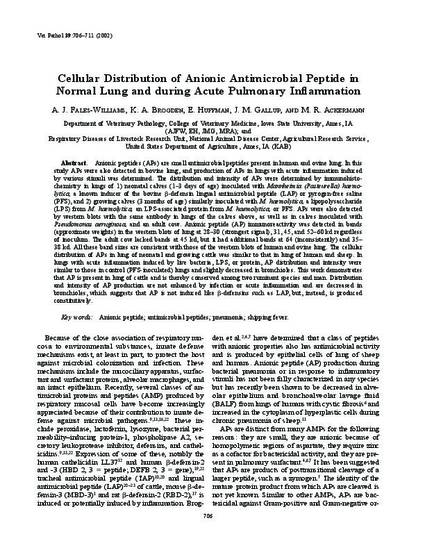
Article
Cellular Distribution of Anionic Antimicrobial Peptide in Normal Lung and during Acute Pulmonary Inflammation
Veterinary Pathology
Document Type
Article
Disciplines
Publication Date
11-1-2002
DOI
10.1354/vp.39-6-706
Abstract
Anionic peptides (APs) are small antimicrobial peptides present in human and ovine lung. In this study APs were also detected in bovine lung, and production of APs in lungs with acute inflammation induced by various stimuli was determined. The distribution and intensity of APs were determined by immunohistochemistry in lungs of 1) neonatal calves (1-3 days of age) inoculated with Mannheimia (Pasteurella) haemolytica, a known inducer of the bovine β-defensin lingual antimicrobial peptide (LAP) or pyrogen-free saline (PFS), and 2) growing calves (3 months of age) similarly inoculated with M. haemolytica, a lipopolysaccharide (LPS) from M. haemolytica, an LPS-associated protein from M. haemolytica, or PFS. APs were also detected by western blots with the same antibody in lungs of the calves above, as well as in calves inoculated with Pseudomonas aeruginosa, and an adult cow. Anionic peptide (AP) immunoreactivity was detected in bands (approximate weights) in the western blots of lung at 28-30 (strongest signal), 31, 45, and 52-60 kd regardless of inoculum. The adult cow lacked bands at 45 kd, but it had additional bands at 64 (inconsistently) and 35-38 kd. All these band sizes are consistent with those of the western blots of human and ovine lung. The cellular distribution of APs in lung of neonatal and growing cattle was similar to that in lung of human and sheep. In lungs with acute inflammation induced by live bacteria, LPS, or protein, AP distribution and intensity were similar to those in control (PFS-inoculated) lungs and slightly decreased in bronchioles. This work demonstrates that AP is present in lung of cattle and is thereby conserved among two ruminant species and man. Distribution and intensity of AP production are not enhanced by infection or acute inflammation and are decreased in bronchioles, which suggests that AP is not induced like β-defensins such as LAP, but, instead, is produced constitutively.
Rights
Works produced by employees of the U.S. Government as part of their official duties are not copyrighted within the U.S. The content of this document is not copyrighted.
Language
en
File Format
application/pdf
Citation Information
Amanda J. Fales-Williams, Kim A. Brogden, E. Huffman, Jack M. Gallup, et al.. "Cellular Distribution of Anionic Antimicrobial Peptide in Normal Lung and during Acute Pulmonary Inflammation" Veterinary Pathology Vol. 39 Iss. 6 (2002) p. 706 - 711 Available at: http://works.bepress.com/mark_ackermann/39/

This article is from Veterinary Pathology 39, no. 6 (November 2002): 706–711, doi:10.1354/vp.39-6-706.